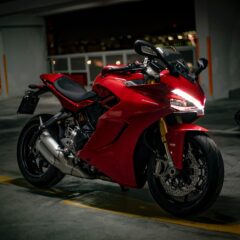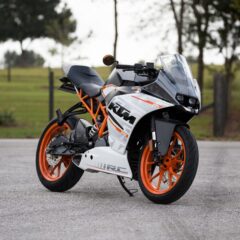
7 Top Motorcycle Accessories
With Christmas just around the corner, you might be wondering what to get your favourite motorcycle enthusiast or even a little something for yoursel...
 Phoenix Motorcycle Training LTD
Phoenix Motorcycle Training LTD
 Phoenix Motorcycle Training LTD
Phoenix Motorcycle Training LTD

One of the essential pieces of kit for riding a motorbike is your lid. Of course, there’s other essential motorcycle gear you’ll need. But you should start from the top, with your helmet. Helmets aren’t just a good idea to have when you’re on a motorcycle; they’re a legal requirement to ride on UK roads. Not only that, they’ll likely save your life if you come off your bike. The Sharp motorcycle helmet rating helps you choose the best one in terms of safety.
Helmets come in a range of styles, sizes and safety ratings. All of them for sale in UK stores have to meet a minimum standard. To help you decide on the right lid, the UK government funds and runs independent helmet testing. It’s pretty rigorous and is called the Safety Helmet Assessment and Rating Program, or as most people know it, Sharp. There’s quite a bit to it, so we’ve explained their motorcycle helmet ratings and what they mean for you.
Sharp put all the helmets they test through the exact same process. They bash them about on curved edges and abrasive flat surfaces to see what happens. This is done from different angles and velocities under specific, controlled conditions. It adds up to 32 different, yet precise, beatings in total, per test. At least seven different helmet samples are used to give the rating for that brand and style.
Once they’ve collected the data, they’ll give the helmet a rating of 1 to 5 stars. The more stars, the better it held up in their tests. A 1-star helmet is still legal, as long as it meets BS 6658:1985 and has the BSI Kitemark, or has the UNECE Regulation 22.05 sticker, or an EEA safety protection that’s equivalent to the British Standard.
Something like a Revzilla helmet won’t have a sharp rating at all. Instead, it’s more likely to have the British Standards and UNECE 22.05 protection stickers along with maybe a DOT and a SNELL. This is largely because Revzilla is an American company and Sharp testing isn’t mandatory for selling lids in the UK or the EU. DOT refers to the Department of Transport in the USA and SNELL is the Snell Memorial Foundation in America – set up in 1957 after Pete Snell, a racing car driver, died in a crash. Sharp testing is vigorous to give detailed results.
As well as the overall star rating Sharp gives helmets, they categorise parts of the helmet in a colour code. This shows you which parts stand up best to a direct impact from a flat surface. Green is the best, followed by yellow, orange, brown, red and finally black which is not very good at all. As the side of the head is particularly vulnerable to injury, it’s good to look at the ratings for this area. Look for a lid with the highest rating for this zone and the overall star rating, to get the best protection you can afford.
All of the helmets used by us on courses have a Sharp rating of 4 or 5. Quality kit not only improves safety, but it also improves your riding pleasure. When you’re able to relax and have fun, you’re able to be a better rider.
With all the safety testing in the world and the highest possible ratings, if your helmet doesn’t fit, it’s not going to do you much good when you need it. Lids are about SO much more than keeping the wind out of your eyes or staying legal on the road. When it comes to the crunch, your helmet is what stands between you getting back on your bike and never riding again. This can’t be stressed enough.
We’re all different and that includes the size and shape of our heads. You want to look for something that fits well under your chin but doesn’t rotate on your head. It shouldn’t wobble up and down either. Keep it on for a minute or two to make sure there aren’t any pressure points that will give you a headache after wearing it for a while. You might want to start checking motorcycle helmet reviews online, but don’t neglect to try some on before you buy.
We’d advise you to always buy new, whether it’s online or in-store. Lids should be replaced every 4 – 5 years and you should know a helmet’s history. One that has been battered about could be compromised in some way. It’s not worth taking the risk.
There are other comfort factors that you should consider too – sound cancelling properties for reducing wind noise, but not too much to leave you deaf when riding. Ventilation is worth thinking about too. You don’t want your head getting really hot in summer. Neither should you feel like you can’t breathe with the visor down. Ventilation will also affect whether or not the visor fogs up in cold weather too.
When you’re looking for a new lid or buying your first one after passing a test, prioritize this piece of kit above all others, shortly followed by gloves. Hands and head often take the brunt of a fall. It’s worth knowing that helmet price won’t indicate safety either. Paintwork, padding and a host of other factors determine the price. Safety is just one factor manufacturers take into account when making lids. Try on as many as you can until you find the one that feels right, has the highest possible overall safety rating for your budget, and has good impact zone ratings too.
Wearing a safety helmet when riding a motorbike is essential for your personal safety, and a legal requirement for riding a motorcycle on the road. Only if you are a member of the Sikh religion and wear a turban for religious purposes are you exempt from wearing a motorcycle helmet. Your motorcycle helmet should meet the basic safety standards listed below:

With Christmas just around the corner, you might be wondering what to get your favourite motorcycle enthusiast or even a little something for yoursel...

If you love motorcycle riding, you’ve probably daydreamed about riding a motorbike for a living. A professional racer or stunt rider is OK for some...

Getting a UK motorcycle licence can seem a complicated process. Particularly when compared to a driving licence for a car. Whether you choose the pro...
This website uses cookies to personalise content, ads, and analyse traffic, sharing data with partners who may combine it with other information. See our Privacy Policy for more information.